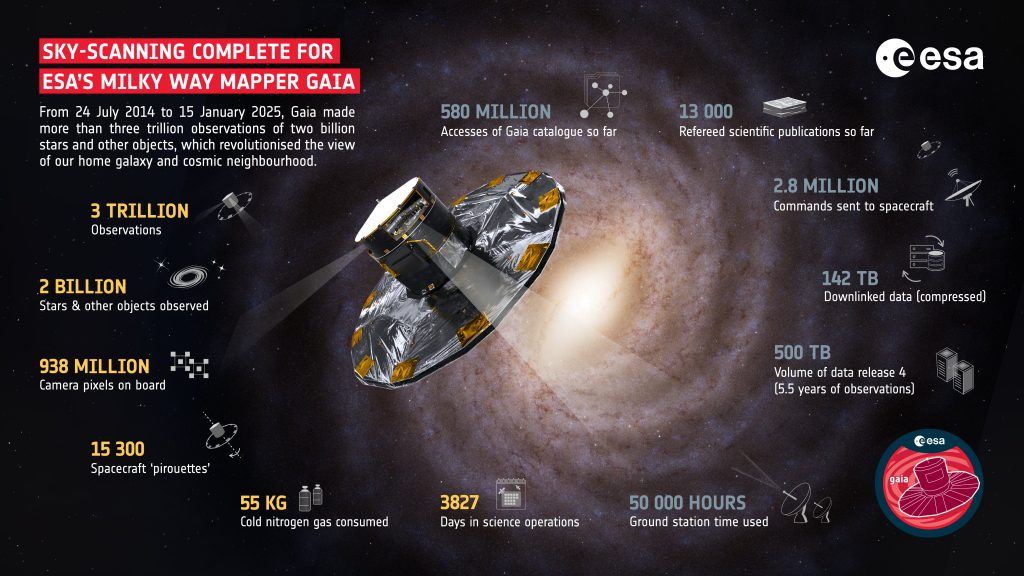Bob Siederer
27 January 2025

Hello again Science Fans!
It is the last week of the first month of 2025, and already it has been an unprecedented month. From the fires in and around Los Angeles to Trump’s first week in office, a lot has happened.
Let’s start with the end of the European Space Agency’s Gaia mission. Gaia saw first light in July, 2014. As the image above shows, it was busy, lasting almost twice as long as expected.
Gaia’s primary mission was to develop a precise map of the Milky Way, our home galaxy. Data from the mission is still being analyzed and we can expect more announcement of discoveries within that data that continue to challenge and change our understanding of our galaxy.
Last starlight for Gaia was on January 15, although the mission isn’t quite complete. Read about what Gaia accomplished and what’s next. There are some beautiful images of the Milky Way in this article, derived from Gaia’s data.

As long as we’re talking about beautiful images, the very next day a huge composite image (2.5 billion pixels!) of our closest neighbor galaxy, Andromeda, was released. It shows more than 200 million individually resolved stars! For more than a decade, the Hubble Space Telescope has been taking pictures of Andromeda and this mosaic is the result. The release of this picture coincides with the 100th anniversary of the discovery of Andromeda by Edwin Hubble, the telescope’s namesake.
The Milky Way and Andromeda galaxies are on a collision course, although we need not worry just yet. It will be 5 to 10 billion years before this happen. Andromeda is believed to have already colided with Messier 32, stealing most of Messier’s stars.
There’s a lot of stuff out in space, and there are lots of security cameras here on earth. Last July a meteorite landed in British Columbia and one of these cameras recorded it. It is believed to be the first time such an event has been captured live, complete with sound.
Last December 20th marked the 5th anniversary of the U. S. Space Force. I have to admit I didn’t think much of the creation of a new branch of the military at the time, but the list of accomplishments in those five years is impressive. Here’s a summary of the first five years.
The Sun is nearing the peak of the current solar cycle, and it has been a very active one. Auroras have been seen at latitudes far closer to the equator than usual, including some around the Bay Area. Now NASA wants to fly two rockets through active auroras to study them. There’s also a lecture on auroras and solar storms this week in San Rafael.
WR 140 is a binary star pair. While there are many binary stars, this one is unusual in that both stars are very massive, luminous stars. They orbit each other in a highly eliptical orbit, meaning most of the time they are far away from each other. But when they get close, things start to happen. The James Webb Space Telescope captured images of WR 140 showing waves of material ejected into space every 7.9 years! Phil Platt’s Bad Astronomy newletter covers this in detail. If you enjoy astronomy, you will probably enjoy Phil’s newsletters.
With the local universities back in session, our calendar is full of events again. Here are some recommendations for you to consider this week:
Wonderfest: The Emotional Brain in a Sleepless World – 01/28/2025 07:00 PM In Novato
NASA’s VIPER Mission: Real-time Collaborative Science Operations at the South Pole of the Moon – 01/29/2025 07:00 PM The Silicon Valley Astronomy Lecture series returns to in-person events at the newly- refurbished Smithwick Theater, Foothill College.
In news from Washington, President Trump has issued an unprecedented list of Presidential Orders that affect both scientific and non-scientific arms of the government. Of the ones that pertain to science in some way, the outlook isn’t good. One order directed the agencies that are part of the Department of Health and Human Services to stop talking to the public. This covers the public health infrastructure. Research conferences have been canceled, some just hours before they were to start. All travel is frozen.
Trump also signaled that the US would leave the World Health Organization. Here’s a reaction from UC Berkeley, via Professor Stefano Bertozzi. WHO isn’t prefect, but pulling out of it would leave the US more exposed to health threats. Trump tried to pull us from WHO in his first term, but was unsuccessful. Here’s some history of WHO’s accomplishments and areas where it could have done better.
The environment also suffered this week with orders for the government to promote fossil fuels and to end a variety of climate policies, this following the hottest year in recorded history world-wide.
From the firing of as many as 15 Inspector Generals, which appears to be in violation of the law, to cancelation of humanitarian programs, such as the Uniting for Ukraine parole program for refugees of the war, Trump is trying to undo years of progress in a very short amount of time. We’ll have to see how many of these actions stand up to court challenges.
As I often do, I recommend Dr. Heather Cox Richardson’s historic take on some of these actions.
Have a great week in Science!
Bob Siederer
Upcoming Events:
Click to see the next two weeks of events in your browser.
